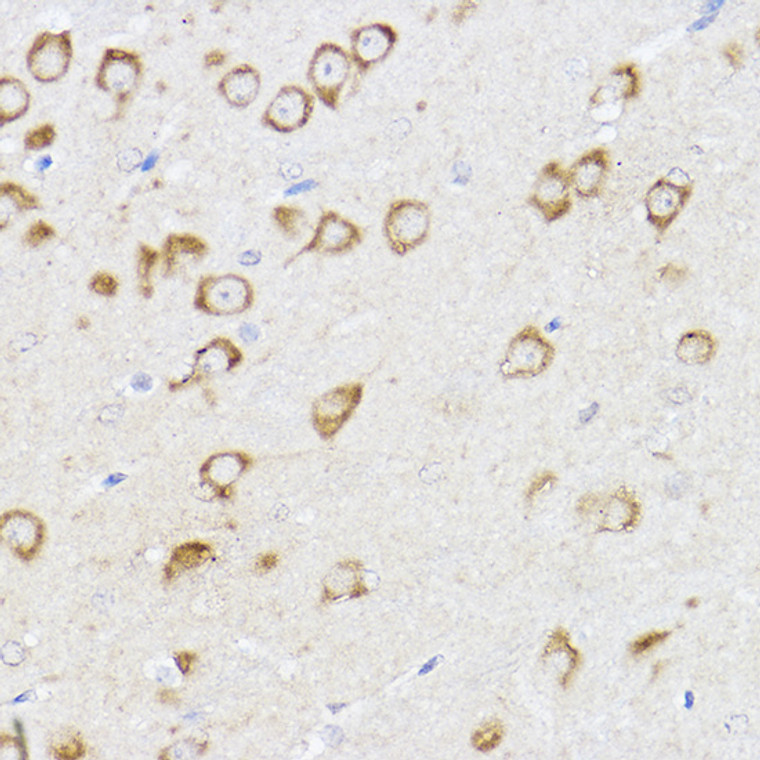| Host: |
Rabbit |
| Applications: |
WB/IHC/IF |
| Reactivity: |
Human/Mouse |
| Note: |
STRICTLY FOR FURTHER SCIENTIFIC RESEARCH USE ONLY (RUO). MUST NOT TO BE USED IN DIAGNOSTIC OR THERAPEUTIC APPLICATIONS. |
| Short Description: |
Rabbit polyclonal antibody anti-MCL1 (150-250) is suitable for use in Western Blot, Immunohistochemistry and Immunofluorescence research applications. |
| Clonality: |
Polyclonal |
| Conjugation: |
Unconjugated |
| Isotype: |
IgG |
| Formulation: |
PBS with 0.05% Proclin300, 50% Glycerol, pH7.3. |
| Purification: |
Affinity purification |
| Dilution Range: |
WB 1:500-1:2000IHC-P 1:50-1:200IF/ICC 1:50-1:200 |
| Storage Instruction: |
Store at-20°C for up to 1 year from the date of receipt, and avoid repeat freeze-thaw cycles. |
| Gene Symbol: |
MCL1 |
| Gene ID: |
4170 |
| Uniprot ID: |
MCL1_HUMAN |
| Immunogen Region: |
150-250 |
| Immunogen: |
A synthetic peptide corresponding to a sequence within amino acids 150-250 of human MCL1 (NP_068779.1). |
| Immunogen Sequence: |
SGNNTSTDGSLPSTPPPAEE EEDELYRQSLEIISRYLREQ ATGAKDTKPMGRSGATSRKA LETLRRVGDGVQRNHETAFQ GMLRKLDIKNEDDVKSLSRV M |
| Post Translational Modifications | Cleaved by CASP3 during apoptosis. In intact cells cleavage occurs preferentially after Asp-127, yielding a pro-apoptotic 28 kDa C-terminal fragment. Rapidly degraded in the absence of phosphorylation on Thr-163 in the PEST region. Phosphorylated on Ser-159, by GSK3, in response to IL3/interleukin-3 withdrawal. Phosphorylation at Ser-159 induces ubiquitination and proteasomal degradation, abrogating the anti-apoptotic activity. Treatment with taxol or okadaic acid induces phosphorylation on additional sites. Ubiquitinated. Ubiquitination is induced by phosphorylation at Ser-159. Deubiquitinated by USP20.leading to increased stability. |
| Function | Involved in the regulation of apoptosis versus cell survival, and in the maintenance of viability but not of proliferation. Mediates its effects by interactions with a number of other regulators of apoptosis. Isoform 1 inhibits apoptosis. Isoform 2 promotes apoptosis. |
| Protein Name | Induced Myeloid Leukemia Cell Differentiation Protein Mcl-1Bcl-2-Like Protein 3Bcl2-L-3Bcl-2-Related Protein Eat/Mcl1Mcl1/Eat |
| Database Links | Reactome: R-HSA-6785807 |
| Cellular Localisation | MembraneSingle-Pass Membrane ProteinCytoplasmMitochondrionNucleusNucleoplasmCytoplasmicAssociated With Mitochondria |
| Alternative Antibody Names | Anti-Induced Myeloid Leukemia Cell Differentiation Protein Mcl-1 antibodyAnti-Bcl-2-Like Protein 3 antibodyAnti-Bcl2-L-3 antibodyAnti-Bcl-2-Related Protein Eat/Mcl1 antibodyAnti-Mcl1/Eat antibodyAnti-MCL1 antibodyAnti-BCL2L3 antibody |
Information sourced from Uniprot.org
12 months for antibodies. 6 months for ELISA Kits. Please see website T&Cs for further guidance









